#2 October 1916
Text














The San Diego Zoo grew out of exotic animal exhibitions abandoned after the 1915 Panama-California Exposition. Dr. Harry M. Wegeforth founded the Zoological Society of San Diego, meeting October 2, 1916
#San Diego Zoo#founded#Zoological Society of San Diego#2 October 1916#USA#Dr. Harry M. Wegeforth#California#original photography#summer 2011#animal#Koala#Great Panda#travel#vacation#Polar Bear#Giraffe#snake#Red river hog#Gorilla#anniversary#US history#Bonobo#landmark#tourist attraction#Rattlesnake#San Diego#aniaml#flora#fauna#nature
4 notes
·
View notes
Text














BOBSTROLOGY
A completely serious presentation by @pegasusdrawnchariots and oatflatwhite
written version under the cut!
♈️Patrick O’Keefe [April 3 1926]
♈️Robert Sink [April 3 1905]
♈️John Julian [5 April 1924]
♈️Renée Lemaire [10 April 1914]
♈️James Miller [11 April 1924]
♈️Walter “Smokey” Gordon [April 15 1920]
♉️~Ronald Speirs [April 20 1920]
♉️Alton More [April 22 1920]
♉️Henry Jones [27 April 1924]
♉️Edward “Babe” Heffron [May 16 1923]
♉️John Martin [May 12 1922]
♉️Joseph Liebgott [May 17 1915]
♉️Norman Dike [May 19 1918]
♉️William Guarnere [April 28 1923]
♊️David Webster [June 2 1922]
♊️George Luz [June 17 1921]
♊️Roy Cobb [June 18 1914]
♋️Frederick “Moose” Heyliger [June 23 1916]
♋️Albert Blithe [June 25 1923]
♋️Donald Hoobler [28 June 1922]
♋️Thomas Meehan [8 July 1921]
♋️John Janovec [9 July 1925]
♋️Robert “Popeye” Wynn [July 10 1921]
♋️James "Moe" Alley [July 20 1922]
♌️~Burton “Pat” Christenson [July 23 1922]
♌️Eugene Jackson [29 July 1922]
♌️Donald Malarkey [July 31 1921]
♌️Edward Tipper [3 August 1921]
♍️Floyd Talbert [August 26 1923]
♍️Alex Penkala [August 30 1922]
♍️William Dukeman [3 September 1921]
♎️Eugene Roe [October 17 1922]
♎️Harry Welsh [September 27 1918]
♎️Lewis Nixon [September 30 1918]
♎️Ralph Spina [October 5 1919]
♎️Thomas Peacock [October 9 1923]
♏️Denver “Bull” Randleman [November 20 1920]
♑️Lynn “Buck” Compton [December 31 1921]
♑️Antonio Garcia [January 17 1925]
♒️Richard "Dick" Winters [January 21 1918]
♒️Herbert Sobel [January 26 1912]
♒️Carwood Lipton [January 30 1920]
♒️Warren “Skip” Muck [January 31 1922]
♓️Lester Hashey [23 February 1925]
♓️Charles “Chuck” Grant [1 March 1922]
♓️Robert Strayer [March 2 1912]
♓️Wayne “Skinny” Sisk [March 4 1922]
♓️Frank Perconte [March 10 1917]
♓️Darrell “Shifty” Powers [March 13 1923]
♓️Joseph Toye [March 14 1919]
6 Aries 🥉
8 Taurus 🥇
3 Gemini
7 Cancer 🥈
4 Leo
3 Virgo
5 Libra
1 Scorpio
0 Sagittarius 🥄
2 Capricorn
4 Aquarius
7 Pisces 🥈
10 🔥
13 🪨
12 💨
15 💧
20 cardinal
17 fixed
13 mutable
22 masculine
28 feminine
#band of brothers#hbo war#bobedit#hbowaredit#bobstrology#astrology#liz makes things#disclaimer: our interpretation is ironclad. we alone decide the law. argue w the wall.#< we say as an aries and scorpio with renee and bull in our corners <3
192 notes
·
View notes
Text
Heinrich Prinz zu Sayyn-Wittgenstein
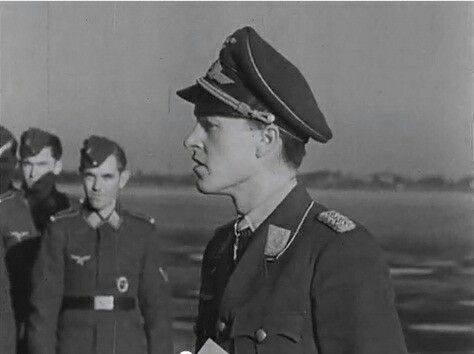
This is Heinrich Wittgenstein, a German Night Fighters ace, timeline:
1916: He was born in Copenhagen
1932: He joined the Hitler Youth
1933: He became a Kameradschaftsführer (group leader).
1933: Adolf Hitler was appointed Reich Chancellor
1933: From Easter until fall of 1933 he led the group's military-sports activities as a Wehrsportleiter
1934: He led the work unit 2/1/113 (Gefolgschaft) and received further pre-military sports training at the different camps of the unit 113 (Bann) and at the Regional Leaders' School (Gebietsführerschule)
1935: He received his Abitur from the Realgymnasium, a higher education facility, in Freiburg in Breisgau.
1937: Wittgenstein decided on a military career and joined the 17. Kavallerie-Regiment (17th Cavalry Regiment) in Bamberg.
1937: He transferred to the Luftwaffe in the summer and, in October, he was accepted at the flight training school in Braunschweig.
1938: He received his officer's commission and was promoted to Leutnant (second lieutenant)
1939: The Second World War began.
1940: Wittgenstein experienced his first combat action on the Western Front in the Battle of France and, later, during the Battle of Britain.
1940: He received the Iron Cross second class.
1940: He received the Iron Cross first class.
1940-41: Wittgenstein returned to pilot school and took his Luftwaffe Advanced Pilot's Certificate 2
1941: In preparation for Operation Barbarossa, the German invasion of the Soviet Union, his unit moved to Eichwalde in East Prussia.
1941: Wittgenstein transferred to the night fighter force. By this time, he had flown 150 combat missions.
1941:
1942: Wittgenstein had left KG 51 by January, after he had volunteered for the night fighter force and been appointed Staffelkapitän (squadron leader).
1942: He claimed his first nocturnal victory.
1942: Wittgenstein received the Knight's Cross of the Iron Cross (Ritterkreuz des Eisernen Kreuzes) on 7 October 1942, after 22 aerial victories.
1943: Wittgenstein was moved to the Eastern Front in February 1943 after he had been appointed Gruppenkommandeur (group commander) of the IV./Nachtjagdgeschwader 5 (IV./NJG 5—4th Squadron of the 5th Night Fighter Wing) on 1 December 1942.
1943: He was appointed Gruppenkommandeur of the II./NJG 3.
1943: Wittgenstein became the 290th recipient of the Knight's Cross of the Iron Cross with Oak Leaves after 54 aerial victories .
1943: Wittgenstein was ordered to take over command of the II./Nachtjagdgeschwader 2 (II./NJG 2—2nd Groupe of the 2nd Night Fighter Wing).
1944: He was appointed Geschwaderkommodore (wing commander) of NJG 2 ; he had already reached 68 aerial victories.
1944: He died on January 21st.
1944: He was posthumously awarded the 44th Knight's Cross of the Iron Cross with Oak Leaves and Swords.
Sources:
Wikipedia: Heinrich Wittgenstein
Military Wiki: Heinrich Wittgenstein
❗❗I DON'T SUPPORT NAZISM,FASCISM OR ZIONISM IN ANY WAY, THIS IS JUST AN EDUCATIONAL POST❗❗
20 notes
·
View notes
Text

Outdoor portrait of 741 Sergeant (Sgt) William Brett Cook from Leongatha, Victoria having just awakened in the desert from a nap on a spell during manoeuvers. A 32 year old musician prior to enlisting on 20 August 1914, he embarked for overseas with G Company from Melbourne on 19 October 1914 aboard HMAT Benalla (A24). After a stopover in Albany, Western Australia, they arrived in Egypt on 2 December 1914. Following further training in Egypt, the battalion took part in the Gallipoli landings on 25 April as part of the second wave. Sgt Cook was promoted to Second Lieutenant on 4 August 1915 at Gallipoli and then after the evacuation back to Egypt, he was promoted to Lieutenant on 20 February 1916. He went with the battalion to France in March where he was awarded the Montenegrin Silver Medal for Bravery during an attack on Pozieres and later Mentioned in Despatches in November. After being promoted to Captain (Capt) on 31 December 1916, he was evacuated to England for medical treatment for an illness in January 1917 and then returned to Australia where his appointment was terminated on medical grounds on 12 March 1918. This image is from the collection of brothers Lt Alan Crawford Couve and 2nd Lt Henry Thomas Ladson Couve from Dandenong, Victoria. They photographed members of their unit in Egypt prior to serving at Gallipoli where they both died.
11 notes
·
View notes
Text
Oc Intro Page
Bianca Maria “B” Hernandez: Born June 30th, 1918, Havana, Cuba, 5’6, she’s insane and willing to fight anyone with no issue, she and her mother immigrated to Washington Heights, New York, in 1923 when she was 5, joined the airborne as a sense of duty and a way to get away from her mother and out of spite towards her mother, rank is Staff Sergeant
Zipporah Josephine “Zippo” Fieldman: Born November 23rd, 1914, Saratov, Russia, 5’7, she will brawl anyone and then go to Shabbos right after, she and her family immigrated to San Francisco, California, in 1916 when she was 2, joined the airborne because she’s always been the oldest sibling and is the only sibling that could go to war, she felt like she had to go as a sense of duty towards her family, rank is Technician 5th Grade (sniper)
Olive-Marie “Ollie” LeBeau: Born April 16th, 1921, New Orleans, Louisiana, 5’4, is usually very calm and collective, can act a little chaotic at times but most of the time is very chill, unless you get her around B and Zippo then she’ll join them in their bs, she will fight a person if need be or drunk enough, technically engaged but she hates her fiance with a passion and was forced to become engaged to him just so her family would let her go into the military, joined the airborne because she wanted to help people and do something with her life, rank is Technician 3rd Grade (nurse/medic)
Marselle Anita Rosaliano: Born April 16th, 1922, Alpine, New Jersey, 5’6, very bubbly and energetic, like a puppy, oblivious to certain things like flirting, and takes a minute to understand dirty jokes, will fight only if necessary or drunk, will be very blunt and tell you off if you really piss her off, she has connections to the mob since her dad runs one, but we don’t talk about that, joined the airborne because she wanted to help people, rank is Private First Class (nurse/medic)
Elizabeth Annabelle “Eliza” Thomlin: Born October 30th, 1923, Asheville, North Carolina, absolutely batshit insane, would probably kill a man with no issues, has severe mommy and daddy issues, hates religion with a burning passion, isn’t afraid of anyone, including Speirs, joined the airborne because she just needed to get away from her normal life and just do something with it, she saw that escape in the airborne, she’s willing to take the risk of death, rank is Corporal (nurse/medic)
Torrance Georgia “Torrie” Stylinski: Born March 27th, 1921, London, England, is a comedian on George’s level, will fight if drunk for shits and giggles, lived in England till she was 10, then moved to Ireland with her mother after her parents divorced, lived there till she was 15 and then basically her whole family on her moms side moved to America after her grandpa died, she’s a mixed albino woman, who currently lives in Hattiesburg, Mississippi, joined the airborne because she wanted to fight, and to get away from her mother, rank is 2nd Lieutenant
Mary Elise McCullen: Born November 15th, 1921, Castle Rock, Washington, has so many issues, like girl is so depressed but she’s vibing and laughing her ass off with Malarkey, Skip and Penk, will fight someone sober for funsies, her dad passed in a motorcycle accident when she was 12, so when she heard about Don and More’s run in with the truck she was PISSED, doesn’t have a great relationship with her mom, but she deals with it, joined the airborne because she wanted to, she saw her chance and took it, rank is Sergeant (mortar squad)
Allison Katherine “Allie” Harten: Born February 12th, 1917, Mountain View, Arkansas, is basically the mother of this group of idiots, is completely and absolutely done with everyone’s bs, both men and women, will call someone out and berate them in front of anyone without care, she doesn’t fight unless absolutely necessary, and doesn’t as drunk as everyone else, somebody's gotta be responsible here, joined the military when she was 18 in 1935, and once they introduced the airborne she joined that immediately, same reason as Lip she wanted to be the best so you gotta be with the best, she joined the military because her father and grandfather were both army men, and she has no brothers, so she decided to do join, it was also to piss her mom off, rank is 1st Lieutenant (intelligence officer)
Julia Ariana Josefina Vasquez-Rodriguez: Born, July 22nd, 1923, The Bronx, New York, the mini B, is treated like everyone’s younger sister, simply because she knew Joe Toye before the war, will fight someone if pissed off, not very hard to do, or drunk, will fight dirty (@blueberry-ovaries, i think you’re gonna love her), the youngest of her full-blooded siblings, moved to Philadelphia when she was 17 because she wanted to and for work, became friends with Joe Toye caused they lived in the same apartment building (yes this is setting up for a fic in the future, hush), joined the airborne because she wanted to, she was in training with the other replacements such as, Heffron, Hashey and Garcia, so she came in right before Market Garden, rank is Private First Class
(Also these girls got some ships to go with them, so i wanna see if y'all, my BoB moots, can guess which guys they go with, a few of them are kinda obvious but still wanna see what y'all think)
17 notes
·
View notes
Text
Ein Heldenleben (A Hero's Life) is an expanded version of Manfred von Richthofen's memoir Der Rote Kampfflieger (The Red Baron). In addition to the autobiography, it includes letters from Manfred to his family (like the 1933 edition) and some chapters that were not included in the book, as well as other comments and anecdotes from people who were close to him. It also includes accounts by his brother Lothar von Richthofen.
Overview:
Visit to the Great Headquarters
My Engagement
A flight in an observation balloon
A day at Staffel 11 (by Lothar von Richthofen)
At Jagdgeschwader Richthofen (by a Dutch reporter)
Richthofen as leader and comrade (by Leutnant Friedrich Wilhelm Lübbert, Jasta 11)
In memory of Richthofen (by v. B.)
An encounter (by Emil August Glogau)
The mother about the boy Manfred
Letter by Leutnant Hans Joachim Wolff to Leutnant Lothar Freiherr von Richthofen
How Richthofen shot down his seventy fifth victory (by Leutnant Lampel)
Richthofen (by Erich von Salzmann):
Part 1
Part 2
Part 3
At court for the second time
Letters of Erwin Böhme: Before the war, Erwin Böhme worked as an engineer in East Africa. When the war started he was already 37 years old. This did not stop him and he became a successful fighter pilot, being personally selected by Boelcke to join his fighter squadron. In 1916 he met the daughter of a former business colleague and they fell in love. The following letters are those Böhme wrote to his later fiancée Annamarie during the war days.
[Translated are the parts of the letters where Böhme describes his life as a fighter pilot.]
Landres, 24 June 1916
Kowel, 7 July 1916
Kowel, 3 August 1916
Kowel, 15 August 1916
Bertincourt, 11 September 1916
Bertincourt, 21 September 1916
Somme, 4 October 1916
Somme, 18 October 1916
Lagnicourt, 31 October 1916
Lagnicourt, 12 November 1916
Jagdstaffel Boelcke, 12 December 1916
Partenkirchen, 28 January 1917
Jagdstaffel Boelcke, 8 April 1917
Valenciennes, 25 April 1917
Valenciennes, 9 May 1917
Valenciennes, 3 July 1917
Jagdstaffel 29, 16 July 1917
Jagdstaffel 29, 7 August 1917
Jagdstaffel 29, 17 August 1917
18 August 1917
Jagdstaffel Boelcke, 21 September 1917
“With the aces”, 20 October 1917
Rumbeke, 31 October 1917
Back with the aces again, 31 October 1917
4 November 1917, Sunday morning
Jagdstaffel Boelcke, 14 November 1917
Bavikhove, 16 November 1917
Bavikhove, 19 November 1917
27 November 1917
The End
Rudolf Berthold – a man who never let himself be dissuaded from his convictions. A man who, despite the worst injuries always returned to the front as quickly as possible. A man for whom the war was not over, even if it was over for his country. A summary of Bertholds life can be found in the pinned post over @subtile-jagden
The following are translated diary entries as well as some of his letters.
Before mobilization
It is getting serious!
First challenges
Emergency landing
Important reconnaissance flights during the advance
The most beautiful day of my life!
Finally a pilot!
Buddecke, the dear comrade!
Feldfliegerabteilung 23
End of 1915
Single seater fighter unit Vaux and the first victories
An unfortunate day for Berthold
Back to the unit
Jasta 4, the Pour le mérite and a new challenge
Beginning of 1917
Finally off to Flanders
End of 1918: Ceasefire and revolution
1919 / 1920: Uncertainties, Soldier´s Councils and the Last Fight
Ernst Jünger was a passionate diarist. During his time in the First World War, he filled 14 diaries. Based on these entries, he wrote his popular book Storms of Steel. The diary entries provide additional information, funny stories and reveal his true feelings during this turbulent time.
First experiences
Officer Candidate and Relocation
First Cannonade
First wound
Back at the front
Days at the front and stories from old friends
Quéant
Friendly contact with the enemy
New year, same situtation
A love affair
Officer training course
Back in the trenches and dangerous patrols
Mine warfare and gas attacks
An English prisoner and a funeral
Summer 1916
Battle of the Somme Part 1
A short break from fighting and another injuriy
Wartime conditions
Another injury
30 notes
·
View notes
Text

Lyudmila Mikhailovna Pavlichenko (Russian: Людмила Михайловна Павличенко; Ukrainian: Людмила Михайлівна Павличенко, romanized: Lyudmyla Mykhailivna Pavlychenko, née Belova; 12 July [O.S. 29 June] 1916 – 10 October 1974) was a Soviet sniper in the Red Army during World War II. She is credited with killing 309 enemy combatants.[2][3] She served in the Red Army during the siege of Odessa and the siege of Sevastopol, during the early stages of the fighting on the Eastern Front. Her score of 309 kills likely places her within the top five snipers of all time, but her kills may be significantly more numerous, as a confirmed kill has to be witnessed by a third party.[4]
After she was injured in battle by a mortar shell, she was evacuated to Moscow.[5] After she recovered from her injuries, she trained other Red Army snipers and was a public spokeswoman for the Red Army. In 1942, she toured the United States, Canada, and the United Kingdom. After the war ended in 1945, she was reassigned as a senior researcher for the Soviet Navy. She died of a stroke at the age of 58
2 notes
·
View notes
Text
#OTD in 1915 – Joseph Mary Plunkett travelled to Germany to join Roger Casement and assist him in his efforts to raise an Irish Brigade and garner German support for the planned 1916 Rising.
Once in Germany, Plunkett met with Casement, a former member of the British Foreign Office, who had travelled from America, funded by Clan na Gael under the leadership of John Devoy. Arriving in Berlin on 31 October 1914, Casement’s mission to Germany had three basic aims:
1. To secure German help for Ireland;
2. To educate the German people about Ireland’s situation so as to gain support for the…

View On WordPress
#1916 Easter Rebellion#1916 Easter Rising#America#Clan Na Gael#England#Germany#Ireland#Joh Devoy#Joseph Mary Plunkett#Roger Casement#Sir Roger Casement
6 notes
·
View notes
Text
Queen Victoria's Currently living Eldest Decendants and Eldest Ever Descendants
This list is as of 19 April 2024
CURRENTLY LIVING
The Lady Pamela Hicks (19 April 1929) (95 years, 0 months, 0 days)
Princess Astrid, Mrs. Ferner (12 February 1932) (92 years, 2 months, 7 days)
Count Bertram Friedrich zu Castell-Rüdenhausen (12 July 1932) (91 years, 9 months, 7 days)
Mrs. Anne Mary Sibylla Liddell-Grainger (28 July 1932) (91 years,8 months, 22 days)
Princess Caroline Mathilde Adelheid Sibylla Marianne Erika von Sachsen-Coburg und Gotha (5 April 1933) (91 years, 0 months, 14 days)
Princess Dorothea Charlotte Karin of Hesse (24 July 1934) (89 years, 8 months, 26 days)
Princess Margaretha Désirée Victoria, Mrs. Ambler (Sweden, 31 October 1934) ( 89 years, 5months, 13 days)
Countess Viktoria Adelheid Clementine Louise von Castell-Rüdenhausen-Von Huntington-Whiteley (26 Februrary 1935)(89 years, 1 months, 24 days)
Prince Edward George Nicholas Paul Patrick, The Duke of Kent (9 October 1935) (88 years, 6 months, 10 days)
Miss Elizabeth Alice Abel Smith (5 September 1936) (87 years, 7 months, 14 days)
Eldest LIVED Descendants:
On 12 June 2025, Princess Astrid, Mrs. Ferner will join this list if she is still living.
Prince Philip, The Duke of Edinburgh (10 June 1921-9 April 2021) ( 99 years, 10 months, 11 days)
Princess Alice of Albany, Countess of Athlone (25/02/1883-03/01/1981) (97 years, 10 months, 10 days)
Queen Elizabeth II of The United Kingdom (21 April 1926-8 September 2022) ( 96 years, 4 months, 18 days)
King Mihai I of Romania (25/10/1921-05/12/2017) ( 96 years, 1 month, 11 days)
Count Carl Johan Bernadotte af Wisborg (Sweden) (31/10/1916-05/05/2012) (95 years, 6 months, 5 days )
The Lady Pamela Hicks (19 April 1929) (95 years, 0 months, 0 days)
Count Sigvard Bernadotte af Wisborg (of Sweden) (07/06/1907-04/02/2002) (94 years, 7 months, 28 days )
Lady Katherine Brandram (Princess of Greece and Denmark) (04/05/1913 02/10/2007) ( 94 years, 4 months, 27 days )
Infanta Dona Beatriz Isabel Federica Alfonsa Eugénie Cristina Maria Teresia Bienvenida Ladislàa of Spain, The Princess of Civitella-Cesi (22/06/1909-22/11/2002) (93 years, 5 months, 1 day)
Patricia Edwina Victoria Mountbatten- Knatchbull , The 2nd Countess Mountbatten of Burma (14/02/1924-13/06/2017) ( 93 years, 4 months)
FACTS:
The Duke of Edinburgh is the husband and third cousin of Queen Elizabeth II, first cousin of Lady Katherine Brandram, The Countess Mountbatten of Burma & Lady Pamela (Mountbatten) Hicks & uncle to Princess Dorothea Charlotte Karin of Hesse. He is also a 1st cousin 1x removed of Queen Sofia of Spain, King Constantine II of the Helenes and Princess Irene of Greece & Denmark and The Duke of Kent (The Duke of Kent’s mother Marina was The Duke of Edinburgh’s first cousin).
Queen Elizabeth II is a 3rd cousin of The Countess Mountbatten of Burma, Lady Pamela Mountbatten, The Duke of Edinburgh. She is the wife of The Duke of Edinburgh. Through her marriage, she is an aunt to Princess Dorothea Charlotte Karin of Hesse. She is a first cousin of The Duke of Kent.
Lady Pamela Hicks is a 3rd cousin of Queen Elizabeth II, a first cousin of The Duke of Edinburgh, her big sister was The Countess Mountbatten of Burma.
Princess Astrid, Mrs. Ferner is a third cousin of The Countess Mountbatten of Burma, The Duke of Edinburgh, Queen Elizabeth II & Lady Pamela Hicks.
The Countess of Althorne was the last surviving grandchild of Queen Victoria. By her marriage, The Countess of Althorne was also a great aunt of Queen Elizabeth II-she married QEII’s grandmother’s brother
King Mihai I of Romania was the last monarch of Romania, he was also a great grandchild of Queen Victoria twice-once through his mother (via Victoria, Princess Royal) and once through his father (via Alfred, Duke of Saxe-Coburg and Gotha)
Sweden’s Count Carl Johan Bernadotte af Wisborg & Count Sigvard Bernadotte af Wisborg were brothers as well as uncles to King Carl XVI Gustaf, Princess Margareta, Mrs. Ambler, Princess Birgitta of Sweden, Princess of Hohenzollern, Princess Désirée, Baroness Silfverschiöld, Princess Christina, Mrs. Magnuson, Queen Margrethe II of Denmark, Princess Benedikte of Sayn-Wittgenstein-Berleburg & Queen Anne-Marie of Greece.
Countess Viktoria Adelheid Clementine Louise von Castell-Rüdenhausen-Von Huntington-Whiteley was a great granddaughter of Prince Leopold, The Duke of Albany, thus a great great granddaughter of Queen Victoria. She is also the younger sister of Count Bertram Friedrich zu Castell-Rüdenhausen.
#Queen Victoria#Queen Victoria's Descendants#British Royals#Greek Royals#Mountbatten Royals#German Royals#Swedish Royals
4 notes
·
View notes
Text

Babe Ruth is the single most famous baseball player in the entire world. Babe Ruth is also one of the greatest baseball players in the history of the game. The Bambino's slugging ability was so great, his last name became an adjective — "Ruthian" — used to describe performances of heroic proportion. We could effortlessly write an entire book (more books about Babe Ruth have been written than any other player) here, but will stick to a mere handful of career highlights.
Babe Ruth the "champion": Ruth was a World Series champion seven times (1915, 1916, 1918, 1923, 1927, 1928, 1932), the American League home run champion twelve times (1918, 1919, 1920, 1921, 1923, 1924, 1926, 1927, 1928, 1929, 1930, 1931), the RBI Champion six times (1919, 1920, 1921, 1923, 1926, 1928), the On-Base Percentage Champion ten times (1919, 1920, 1921, 1923, 1924, 1926, 1927, 1930, 1931, 1932) and the Slugging Average Champion thirteen times (1918, 1919, 1920, 1921, 1922, 1923, 1924, 1926, 1927, 1928, 1929, 1930, 1931)!
Babe Ruth the "home run king": Ruth was the first player in Major League history to hit 200, 300, 400, 500, 600 and 700 home runs. In 1919, Ruth hit 29 home runs becoming the all-time single-season home-run leader. A year later Ruth hit 54 home runs, breaking his own record as the all-time single-season home run leader and became the first player to hit over 50 home runs in a season. The very next year, he hit 59 home runs, breaking his own record yet again. Finally, in 1927, The Sultan of Swat hit 60 home runs, breaking the mark and establishing a plateau that was legendary for decades. Currently, Ruth still holds records for most home runs in any decade (467 in the 1920s), fastest player to hit 600 home runs (2,044 games) and fastest player to hit 700 home runs (2,418 games).
Babe Ruth the "best left-handed pitcher in baseball": Ruth was 18-8 with a 2.44 ERA his first full season on the mound (1915), twenty-wins club (23-12) the very next year (and the ERA Champion, 1.75), and twenty-wins club (24-13) the year after that. Ruth still holds pitching records for most shutouts in a season by a lefty with 9 (tied by Ron Guidry in 1978) and most innings pitched (14) in a World Series game, on October 9, 1916, a complete game 2-1 victory.
Babe Ruth the "postseason prince": Ruth set World Series records with 3 homers in a game (and did it twice) and 12 total bases in a game. His 15 postseason home runs, all hit during World Series games, were a record until Mickey Mantle tied him in 1963 then eventually passed him in 1964. And let us never forget the 1932 World Series, legendary and debatable still to this day, courtesy of "The Called Shot".
Babe Ruth the "nickname collector": Babe (which some actually believe is his real name due to its use) probably had more well-published nicknames than any other player and here are but a few we have seen in print: The Bambino, The Sultan of Swat, The Colossus of Clout, The Wazir of Wham, The Maharajah of Mash, The Rajah of Rap, The Caliph of Clout, the Behemoth of Bust, The Mammoth of Maul, The Mauling Mastodon, The Mauling Monarch, The Wali of Wollop, and to his teammates, Jidge.
Babe Ruth the "hall of fame legend": Ruth was elected to the Baseball Hall of Fame on February 2, 1936, by the Baseball Writers Association of America, as part of the inaugural class of inductees. At the time of his induction, Ruth held literally hundreds, and we mean hundreds, of baseball records. The single most prolific hitter in baseball history, a key component in "Murderer's Row" and a charismatic personality — both on and off the field — that made him a larger-than-life figure and one of the greatest sports heroes, not just in baseball, but in American culture.
Babe Ruth is part of an elite set of pitchers in Major League history whose career on the mound spanned at least ten seasons and NEVER once included a losing record! The other aces: Spud Chandler (11 seasons), Dizzy Dean (12 seasons), Dave Foutz (11 seasons), Joe McGinnity (10 seasons), Andy Pettitte (18 seasons), Deacon Phillippe (13 seasons), Jay Powell (11 seasons) and Urban Shocker (13 seasons).
9 notes
·
View notes
Photo










The San Diego Zoo grew out of exotic animal exhibitions abandoned after the 1915 Panama-California Exposition. Dr. Harry M. Wegeforth San Diego Zoo the Zoological Society of San Diego, meeting October 2, 1916.
#San Diego Zoo#Zoological Society of San Diego#2 October 1916#US history#anniversary#Balboa Park#San Diego#summer 2011#original photography#flora#fauna#Giant Panda#polar bears#Red river hog#koala#giraffe#chimpanzee#snake#California#vacatioh#travel#tourist attraction#landmark#cityscape#animal#nature
3 notes
·
View notes
Text
Oswald Boelcke - Part 3
Der Meister
The war diary of the squadron reads on August 27th, 1916: “Jagdstaffel 2 meets under the leadership of Captain Boelcke. Officers and enlisted men come from different departments. Existing: 3 officers, 64 non-commissioned officers and enlisted men. - Accommodation: officers live in Bertincourt, enlisted men in barracks. - Airplanes: there aren't any yet. - Activity: setting up the airport.”
Boelcke had a lot of work to do in the following weeks to get the unit fully operational. In early September Richthofen and Boehme arrived, as well as Max Müller (a very successful Bavarian pilot, see: https://www.tumblr.com/subtile-jagden/714297390685929472/just-finished-this-book-about-max-ritter-von?source=share).
On the 2nd September Boelcke used one of the three so far arrived aeroplanes and shot down his 20th victory. This highly puplished event hit like a bomb; after all, the people hadn't heard from Boelcke for almost two months. As Boelcke was almost the only one with a plane, he flew a lot and shot down five enemies in the first half of September.
Finally, on the 17th September some more machines arrived so that the Staffel could fly together for the first time, resulting in victories for Boelcke, Böhme, Richthofen and Reimann. About his new students he writes his parents: “My gentlemen are all very passionate and eager and capable, but I still have to train them to properly work together – in their eargerness to achieve something, they sometimes still are like young dachshunds.”
Boelcke, like most of the pilots, had no personal contempt against his opponents: “We have nothing at all against the individual pilot, we only fight his flying against us.”
Just as they were able to complete their set-up, English bombers and artillery attacked Bertincourt, causing Boelcke to move his Staffel. By then Boelcke was able to up his victory list to 31. The fighting on the Somme weakened significantly, partly because the fighter pilots' excellent performance ensured that enemy aviators were no longer able to see behind German lines. Boelcke enjoyed great popularity with his men. He was strict and demanding but never without reason. “It is difficult to express with what devotion and love we clung to him in our inner circle of comrades. Never before has a comrade been loved by his comrades, a superior by his subordinates, as he has.”
In his last ever letter, Boelcke told his parents about his 35th victory on the 17th October. On the 26th he shot down number 40. On the 28th his life was over.
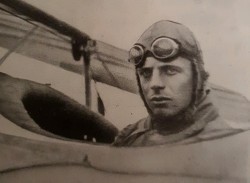
The End
The stress of the hard fights and worries about the future did not go unnoticed. “My captain became more and more serious and haggard”, reported Boelcke's orderly. On some day he went up seven times and on the ground he had a lot of organisational work to do. He was supposed to go on leave but “I am needed here!”.
At seven a.m. first reports of English planes over the lines alerted Boelcke to start with his own men to fight them off. Four times they went up, all that before it was even noon. At around five p.m. they were called upon once more for help.
Oswald Boelcke is undefeated in the air. No enemy brought him down. It was unfortunately one of his own man who collided with him in what was a pure accident. Erwin Böhme, handpicked by Boelcke to join him and a great admirer of him, writes to his fiancé about the tragic event: “Boelcke and I had an Englishman between us when another enemy, being chased by friend Richthofen, cut our way. Boelcke and I, hampered by our wings, didn't see each other for a moment while we were avoiding each other at lightning speed - and that's when it happened. Our planes brushed against each other, just a light touch, but fatal at the high speeds. Fate is usually so cruelly unreasonable in its choice: only one side of the undercarriage was torn away from me, the outermost piece of the left wing was torn away from him. I had to see how he couldn't straighten his machine anymore and how he crashed next to a battery position. I was utterly distraught, but still had hope. But when we got there in the car, the body was already being brought towards us. He died instantly at the moment of impact. Boelcke never wore a crash helmet and didn't buckle up in the Albatros either - otherwise he might have survived the not-too-violent impact.”
Manfred von Richthofen also reported on the incident: “I look around and observe how Boelcke is attacking his victim about 200 m next to me. A good friend of his flies by. Both shot - the Englishman was about to fall at any moment. Suddenly, an unnatural movement can be observed in the two airplanes. I had never witnessed a mid-air collision and had imagined it to be much different. It was just a touch. But at the speed that such an airplane has, every light touch is a violent impact.”
Interesting is the fact, that Richthofen doesn´t mention going after an enemy himself, crossing in front of Boelcke and Böhme. Maybe he did not realize that he did, maybe it was not something that the public should know. Richthofens account is in his biography “Der Rote Kampfflieger”, published at the hight of his popularity. To give the impression that he was partially to blame for Boelcke's death would be fatal.
In the end no one was to blame as it was a truly unfortunate accident. But of course Boehme was devastated. “Outwardly, I've got myself under control again to some extent. But in the quiet hours I always remember the horrible moment when I had to see my master and friend fall next to me - the nagging question arises again and again: Why did he, the irreplaceable one, and not I have to be the victim of this blind fate - because neither he nor I was to blame for the disaster?!”.
When Boelckes family came to escort his body home, they met with Böhme and a friendship betweem them was formed that lasted until Boehmes own death one year one month and one day after Boelcke´s.
The death of this national hero sent a shockwave through the Empire and the German front lines. Boelcke is no more!
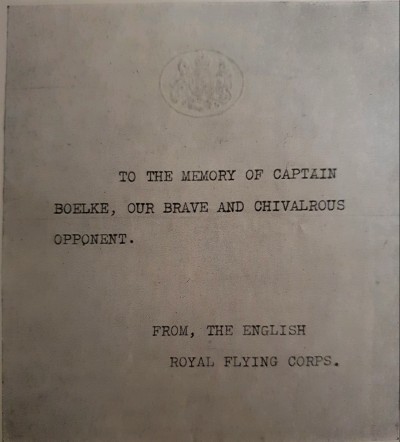
On the 31st October 1916 the funeral ceremony took place in Cambrai. The coffin was laid out in front of the altar of the cathedral. Crown Prince Rupprecht of Bavaria appeared at the head of the generals, and General von Below represented the Kaiser. Manfred von Richthofen carried Boelcke's Ordenskissen (pillow with all his medals).
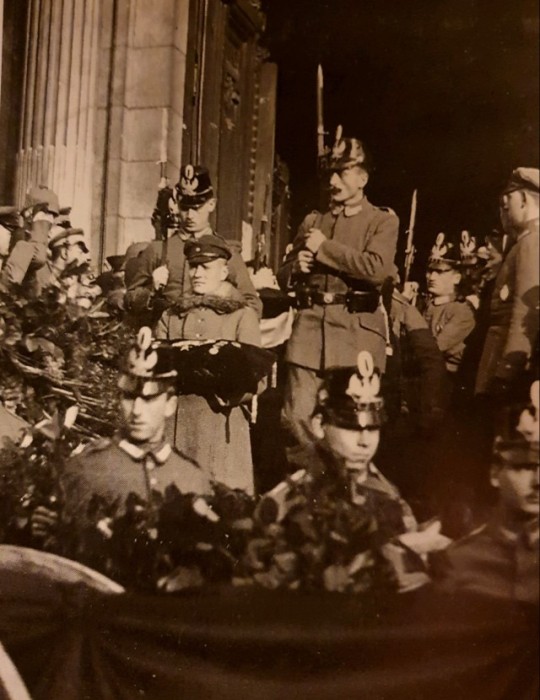
He was laid to rest in his home town of Dessau.
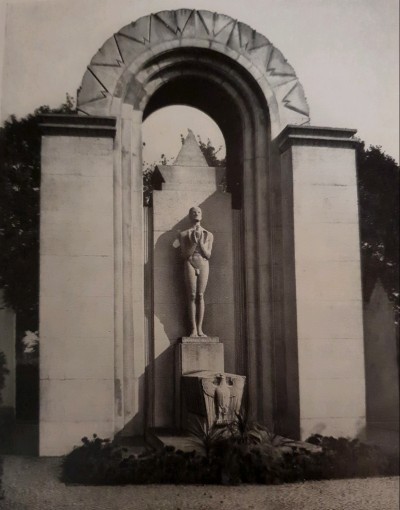
On the front the fight rages on. New pilots filled the gaps of the fallen. Inspired by Boelcke's spirit, best expressed by General Thomsen: "I want to be a Boelcke!"
Sources:
Boelcke, by Prof. Dr. Johannes Werner (1932)
Der Rote Kampfflieger, by Manfred von Richthofen (1917)
Briefe eines deutschen Kampffliegers an ein junges Mädchen, by Prof. Dr. Johannes Werner (1930)
Immelmann, der Adler von Lille, by Franz Immelmann (1934)
8 notes
·
View notes
Text
Adventuresses Like Phryne

Last month, we talked about the Van Buren sisters and their legendary transcontinental motorcycle trip in 1916. As impressive as their feat was, they weren’t the first women to cross the US by motorcycle.
That distinction belongs to Adventuresses Effie and Avis Hotchkiss, who did it in 1915.
Effie Hotchkiss was a young woman ahead of her time. She learned to ride and fix motorcycles when she was 16. At 18, she was working on Wall Street, something almost unheard of at the time.
But she still craved adventure – she wanted to be the first woman to cross the US on a bike. The 1915 World’s Fair in San Francisco gave her that chance. On May 2, 1915, she set off from Brooklyn on her Harley-Davidson 11-F with her mother, Avis, in the sidecar.
“We merely wanted to see America and considered that the three-speed Harley-Davidson for myself, and sidecar for mother and the luggage best suited for the job.” Effie said.
The roads were challenging, to say the least, often little more than dirt paths – until the rain came, and they became mud pits. The roads took their toll on the duo’s tires. They would eventually run out of replacement inner-tubes and had to resort to cutting and rolling up a blanket to repair a flat.
In spite of the conditions, Avis never lost confidence in her daughter. "I do not fear breakdowns. For Effie, being a most careful driver, is a good mechanic and does her own repairing with her own tools."
She was also a good shot, which proved necessary for their less than friendly encounters with coyotes and rattlesnakes.
The pair reached San Francisco and the Fair in August 1915. They made their way to the beach and poured the jar of Atlantic seawater they’d carried from New York into the Pacific Ocean. Then, they turned around and drove home.
They completed their 9,000-mile adventure in October 1915. In 2022, 107 years after the trip, Effie Hotchkiss was inducted into the American Motorcycle Association’s Hall of Fame.
#adventuress #adventuresses #AdventuressesWeLove #motorcycle #harley #harley-davidson
17 notes
·
View notes
Text
Alexei's 1916 diary
25 October, 1916. In the morning I went with Papa to see the new recruits of the 4th Infantry regiment. From there I went to the infirmary, where Mama was. Had breakfast with ours. At 2 o’clock in the afternoon we went to Stavka. They played «Naine Jaune» on the train. Zhylik read to me. Went to bed early.
28 October. Got up at 9 o’cl. …. We arrived in Kiev at 10 o’cl….. Grandmama met us. Rode to the St. Sophia Cathedral. After molebna went to the palace. After breakfast I went to the review of the cadets, performed by the officers. Went to visit the sick Aunt Olga at her infirmary. At 6 o’cl…. returned to the train. Mama wrote.

Source: The Romanov Family: Alexei Nikolaevich Romanov Diary (1916). Compiled by Helen Azar.
16 notes
·
View notes
Note
Hi, I’m wondering if you have any info on how the Franconia of 1910 went down. Every article I’ve seen discussing it only ever says “she was torpedoed and sunk, the end” but I’ve never found where the torpedo hit, or anything saying she went by the head or by the stern. Any details would be greatly appreciated.
Unfortunately, I also haven't found much. I think that this may unfortunately be lost to history. Losing ships to U-Boats was a fairly common occurrence, so i wouldn't be surprised if no one bothered to write down specifics. If it was recorded somewhere, I wouldn't be surprised if it wasn't available to the public / online. Heres the extent of what I was able to find (largely copy pasted from other sources):
On 4th October 1916, the Cunard liner Franconia, employed as an auxiliary transport, was en route from Alexandria to Marseille, when she was torpedoed and sunk by the German submarine UB-47. She was 195 miles E 1/2 S of Malta, and fortunately, she was not carrying troops. Of her crew of 314 twelve were killed. 302 were rescued by the hospital ship HMHS Dover Castle. She was struck in one of the boiler rooms, the explosion killed 12 firemen and trimmers, one of which was aged 16.
5 notes
·
View notes
Text
Who was the first woman (or women) to cross the Continental United States by motorcycle(s).

Adeline and Augusta Van Buren have been accredited as being the first women to cross the United States on motorcycles. This however is not entirely true. But these sisters most certainly are the third and fourth to do so. Yet they are the first to do so with each on their own individual motorcycle; as the two women to make the cross-country trip one year prior, did so as one riding the motorcycle while the other rode as a passenger in a sidecar.

The Van Buren sister's trip began on July 4th, 1916 originating from New York, riding first to the Indian Motorcycle factory in Springfield, Massachusetts on two Indian Power Plus model motorcycles.
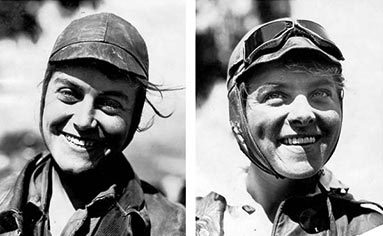
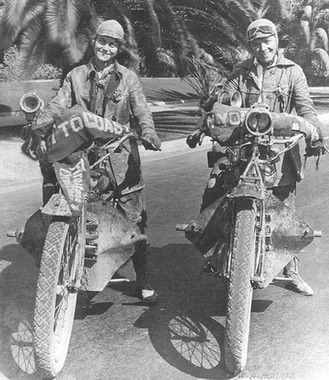
Their cross-country ride would take them all the way to the West Coast, before completing their trip on September 8, 1916 in California near the U.S./Mexico Border.

Well if the Van Buren sisters weren't the first women to ride across the U.S. on a motorcycle, then who was?

The very first two women to cross the United States via motorcycle were Effie Hotchkiss and her mother, Avis. In 1915, Effie purchased a brand new Harley-Davidson F-11 motorcycle and purchased a sidecar to accommodate her mother as a passenger for the long trip.
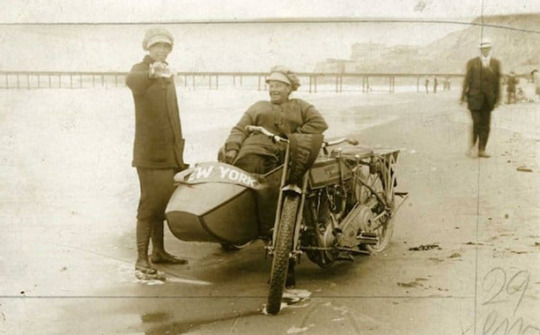
Their trip to San Francisco, California originated in Brooklyn, New York on May 2, 1915.

With stops in Chicago, St Louis, Colorado Springs, Santa Fe, The Grand Canyon, and Los Angeles, Effie and her mother Avis arrived in San Francisco, CA in August, 1915 (still searching to verify the exact date),
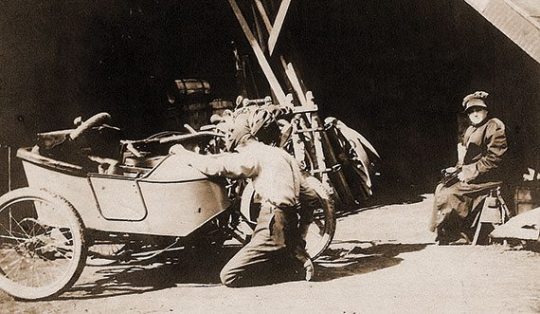
and returned to New York, completing their 9,000 mile trip at their Brooklyn home on October 11, 1915 after stopping first at the W&V Beecroft hardware store in Ossining, NY.
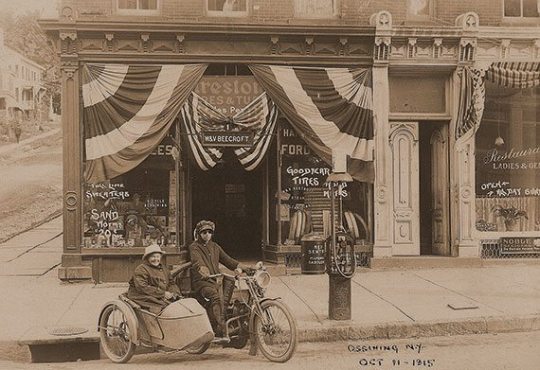
Avis (in the sidecar lovingly dubbed "The Bathtub") and Effie Hotchkiss on her motorcycle, a 1915 Harley-Davidson F-11. October 11, 1915.
Note: I do not own any of the images in this article, and have presented both images and information herein as an educational expose' to bring to light the abilities of America's first female motorcycle pioneers. It is therefore believed by the author that "Fair Use" applies.
Presented by: m.a.Kenny
12 notes
·
View notes